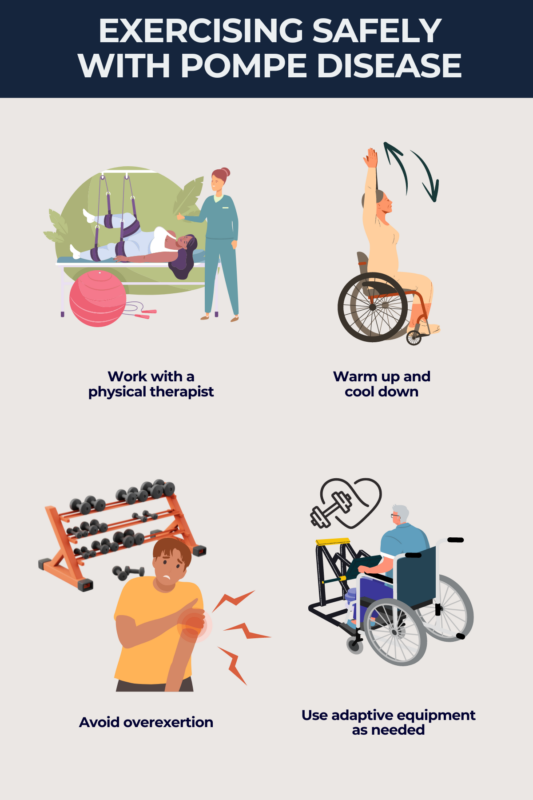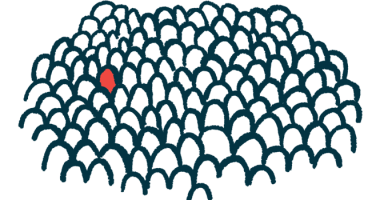Staying active with Pompe disease: Exercise and physical therapy
Last updated Aug. 6, 2024, by Susie Strachan

Pompe disease causes progressive muscle weakness, but regular exercise and physical therapy can help preserve muscle strength and flexibility. It also can slow the progression of this rare disease to help maintain independence.
Pompe disease management includes enzyme replacement therapy and supportive treatments such as physical therapy.
A physiotherapist can teach you safe exercises for Pompe disease. They also can help you avoid activities that might cause excessive strain or pain.
Benefits of exercise for Pompe disease
A chronic illness like Pompe can make it increasingly difficult to exercise.
Physical therapy is generally recommended to preserve muscle strength as progressive weakness affects your mobility and the ability to do even basic movements.
As the disease progresses and your endurance and mobility decrease, you will probably need mobility aids, such as a power scooter or wheelchair.
Exercise also can support pain management as well as heart and lung health.
Other benefits of exercise for Pompe disease include supporting mental health, reducing chronic fatigue, and avoiding health complications.
Improving muscle strength
Regular movement can help prevent muscle atrophy, joint stiffness, and other health issues associated with decreased mobility.
When you improve strength, you:
- increase flexibility
- maintain joint health
- prevent contractures (shortened and hardened muscles and tendons)
- reduce muscle stiffness and soreness
- reduce risk of falls.
Increasing cardiovascular health
People living with Pompe may develop enlarged heart (cardiomegaly), which can lead to complications such as heart failure, arrhythmias, and reduced cardiac function.
Regular cardiovascular exercise strengthens your heart so it can pump blood more effectively, which can increase energy levels and endurance.
Because Pompe causes muscles to lose strength, including the diaphragm muscles that help support the lungs, many people with Pompe have breathing difficulties.
Exercises targeting the diaphragm and other respiratory muscles can improve your capacity to breathe and reduce the risk of respiratory complications such as pneumonia.
Boosting mental health
Regular physical activity can reduce stress and anxiety by:
- increasing production of serotonin, a feel-good hormone that helps regulate your mood
- taking your mind off worries and negative thoughts
- improving the quality of your sleep, allowing your body to rest and recuperate
- widening your social circle by exercising with other people
- giving you a sense of accomplishment from achieving exercise goals, no matter how small.
Helping prevent further complications
Pompe can be complicated by other health conditions, such as scoliosis (curvature of the spine) and weakened bones, as well as high blood pressure.
Exercise can help you:
- increase your core muscle strength to prevent scoliosis
- strengthen your bones to prevent fractures
- decrease high blood pressure.

Safe exercises for people with Pompe
Your healthcare team will take into account your current capabilities, strengths, and limitations when putting together a program of safe exercises for Pompe disease.
It’s important not to overdo it. Too much exercise can worsen fatigue and muscle weakness, and potentially damage muscles.
Ways to stay safe when exercising include:
- starting off gently to avoid injury
- doing a warmup and cooldown
- stopping if you feel pain
- exercising on a nonslip surface to reduce the risk of falling
- keeping your exercise area free of obstacles.
Certain types of exercise are less likely to damage muscles, including those that are low-impact and increase strength, flexibility, and balance.
Low-impact aerobic exercises can minimize stress and impact on your joints and muscles, and strengthen your heart and lungs.
Low-impact aerobic exercises that may be good for people with Pompe include:
- aquatic exercise
- walking, using an assistive device for outdoor surfaces
- stationary cycling.
Strengthening exercises, such as doing gentle resistance training with resistance bands and light weights, can help maintain muscle strength. These types of exercises can help maintain core muscle stability and posture, along with the larger muscle groups such as those in the shoulders and hips.
Flexibility exercises can include range-of-motion exercises, such as upper body stretches for the arms, shoulders, and neck, along with lower body stretches for the lower back, hips, and knees.
Exercises to avoid
Some types of exercises people with Pompe disease should avoid include:
- high-impact exercises such as running, jumping, and contact sports, which can stress joints and muscles, and cause muscle fatigue
- heavy weightlifting, which can potentially cause muscle damage
- exercises that require good balance and have a high risk of falls, such as skateboarding, surfing, and skiing.
If you are not sure whether a physical activity is safe and suitable, consult your healthcare team. It may be possible to make adaptations to reduce risk and accommodate your capabilities.
Benefits of physical therapy
Physical therapy for Pompe disease can help improve mobility and flexibility.
A physiotherapist can assess your abilities, make sure you are doing exercises the right way, and tailor a plan to your specific needs, including an exercise plan designed to increase stamina without causing excessive fatigue.
An exercise plan might include:
- stretching exercises to minimize tightness in your hands and upper limbs
- stretching exercises to help prevent contractures
- balance exercises to prevent falls.
Because Pompe frequently affects the skeletal muscles — such as in the trunk, legs, and hips — which are essential for movement, you may become unbalanced, leading to an increase in falls.
A physiotherapist can show you techniques to help you manage these changes, including how to stand up safely after a fall. They can also teach you how to incorporate adaptive equipment, such as a walking aid or wheelchair, into exercise.
Additional tips for staying active
Staying physically active with a chronic condition like Pompe is not easy. It takes dedication and commitment, but it also has the potential to help you maintain physical health and improve your quality of life.
- Start slowly with low-intensity exercises and gradually increase the duration and variety of exercises and activities.
- Listen to your body and take breaks when you feel fatigue or pain.
- Get enough rest to allow the body to recharge.
- Eat a healthy diet and keep hydrated so you have enough energy to exercise.
Pompe Disease News is strictly a news and information website about the disease. It does not provide medical advice, diagnosis, or treatment. This content is not intended to be a substitute for professional medical advice, diagnosis, or treatment. Always seek the advice of your physician or other qualified health provider with any questions you may have regarding a medical condition. Never disregard professional medical advice or delay in seeking it because of something you have read on this website.
Related articles






